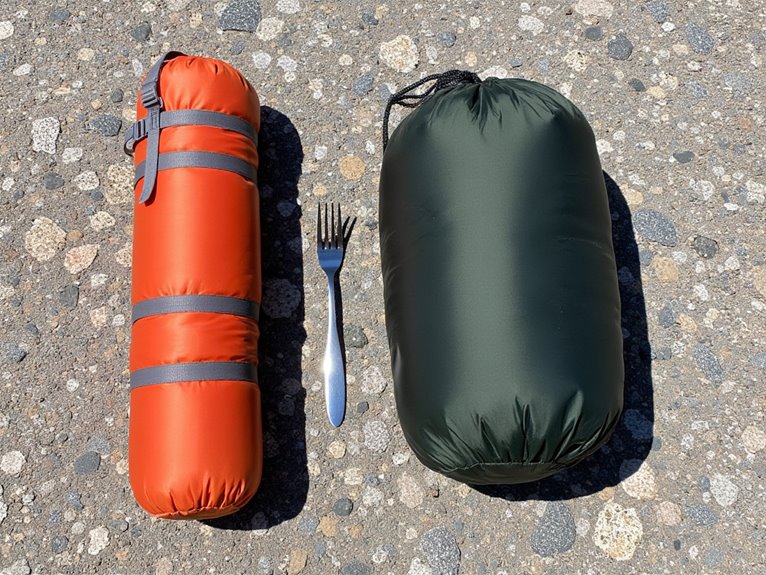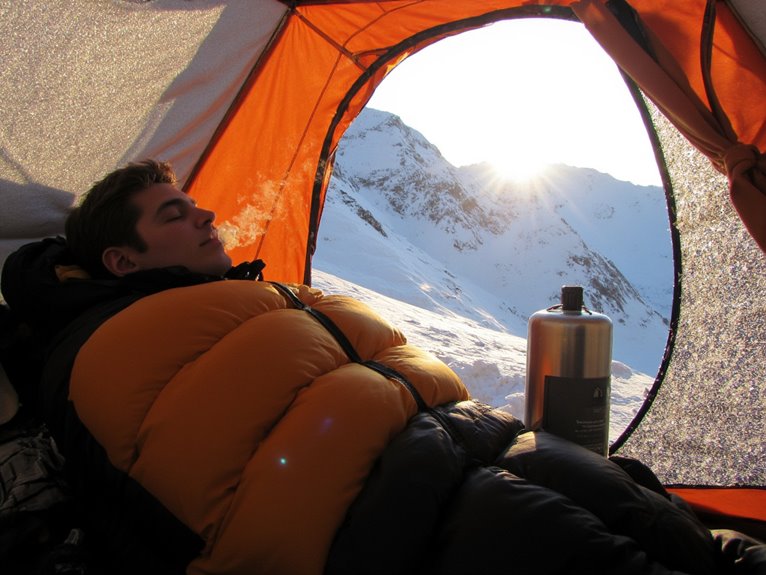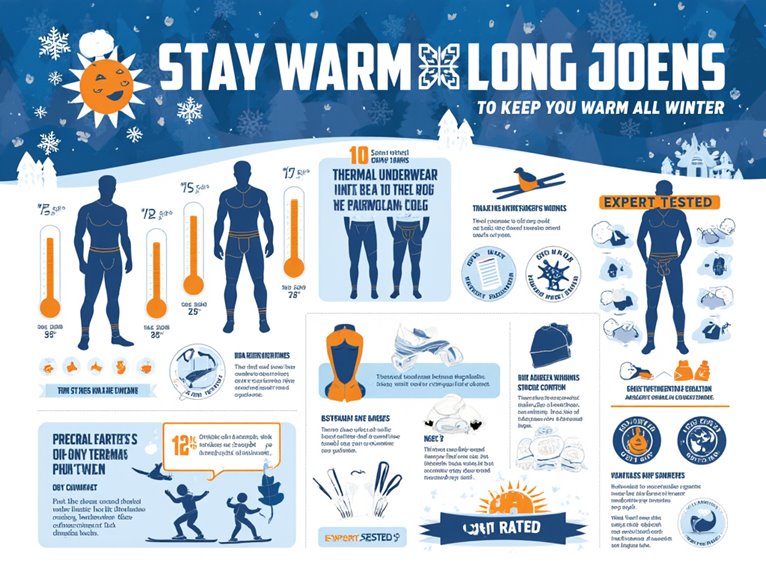Compression Sacks vs. Stuff Sacks: Packing Your Sleep System Right
You’ll choose compression sacks when you need maximum volume reduction for high-loft gear like down sleeping bags, achieving up to 50% space savings through strap-tightening mechanisms. Stuff sacks work better for organization and quick access, using lighter materials while conforming naturally to your pack’s contours. Compression sacks utilize heavier 40D-70D nylon fabrics for durability, while stuff sacks prioritize lightweight 30D materials. Your camping style determines the right choice—backpackers benefit from compression efficiency, while day campers prefer stuff sack versatility for gear that doesn’t require aggressive compression.
We are supported by our audience. When you purchase through links on our site, we may earn an affiliate commission, at no extra cost for you. Learn more. Last update on 10th December 2025 / Images from Amazon Product Advertising API.
Notable Insights
- Compression sacks reduce sleeping bag volume by up to 50% using straps, while stuff sacks prioritize organization and gentle storage.
- Use compression sacks for down sleeping bags only temporarily; synthetic fills tolerate compression better for extended periods.
- Stuff sacks conform naturally to backpack contours and offer better accessibility compared to rigid compressed shapes.
- Multi-day backpackers benefit from compression sacks’ space savings, while day campers can use lighter stuff sacks effectively.
- Waterproof sacks are essential for down protection in wet conditions; water-resistant options suffice for synthetic fills.
Understanding the Fundamentals of Compression and Stuff Sacks
When you’re selecting between compression sacks and stuff sacks for your gear, understanding their fundamental differences will determine your packing efficiency and equipment protection.
Compression sack basics center on volume reduction for lofty items like sleeping bags and down jackets. These sacks utilize straps or buckles to compress contents to approximately one-third their original size.
They create uniform, rectangular or cylindrical shapes that fit efficiently in backpack compartments. However, their rigid compression makes them unsuitable for long-term storage due to potential fill damage.
Stuff sack versatility lies in their adaptable design for general organization. They accommodate various gear types without aggressive compression, conforming naturally to your backpack’s contours.
Many offer water-resistant properties for wet conditions. Their flexible construction allows better shape adaptation compared to compression sacks’ structured approach. Quality compression sacks like Borogo and Frelaxy can reduce bulk by up to 40%, making them ideal for optimizing pack space during extended adventures where every cubic inch matters.
Material Construction and Durability Differences

Although both compression and stuff sacks serve similar organizational purposes, their material construction differs considerably in weight, durability, and manufacturing approach.
Compression sacks typically use heavier fabrics ranging from 40D to 70D nylon for enhanced material durability. They’re built to withstand repeated compression cycles and mechanical stress from straps and buckles.
Compression sacks utilize robust 40D to 70D nylon fabrics engineered to endure constant compression forces and hardware-induced stress.
Stuff sacks prioritize fabric weight reduction, often using 30D nylon or Ultra-Sil materials. You’ll find Dyneema Composite Fabric in premium ultralight models, offering exceptional strength-to-weight ratios.
Silnylon provides waterproof protection through silicone treatment, while basic nylon and polyester require additional coatings.
Material blends in compression sacks combine nylon and polyester for superior durability.
Stuff sacks focus on minimizing pack weight, sacrificing some longevity for portability advantages.
Space Efficiency and Volume Reduction Capabilities
The fundamental difference between compression and stuff sacks lies in their volume reduction capabilities, which directly impacts your pack’s spatial efficiency.
Compression sacks mechanically reduce sleeping bag volume by up to 50% through strap-tightening mechanisms that squeeze out air. Stuff sacks simply contain gear without reducing its original volume.
Compression efficiency varies greatly by material type:
- Down sleeping bags achieve maximum compression ratios due to their highly compressible loft structure.
- Synthetic bags compress less effectively, typically reducing volume by 20-30%.
- One large compression sack outperforms multiple smaller ones for storage optimization.
- Adjustable compression allows incremental volume control versus stuff sacks’ fixed capacity.
Down bags benefit most from compression technology, while synthetic materials offer limited space savings.
This mechanical advantage directly translates to increased pack capacity for additional gear.
Premium models with four adjustable straps provide even pressure distribution for optimal compression results compared to basic single-strap designs.
Choosing the Right Sack for Your Sleep System Components
Your sleep system’s individual components require different sack strategies based on their specific characteristics and compression tolerances.
Down sleeping bags demand careful handling to prevent loft damage, while synthetic fills tolerate aggressive compression.
Bulky sleeping pads often resist standard compression entirely.
Temperature ratings don’t always correlate with packed size, so you’ll need to match sack capacity to your gear’s actual volume rather than its warmth specifications.
Sleeping Bag Compression
When selecting compression gear for your sleeping bag, you’ll face a fundamental choice between compression sacks and standard stuff sacks that directly impacts your pack’s size and weight distribution.
Compression sacks excel with different sleeping bag types, reducing bulky down and synthetic bags to one-third their original size. The compression benefits become essential when backpack space is limited.
Down bags compress more efficiently than synthetic alternatives due to their loft characteristics.
Consider these size guidelines for ideal performance:
- Small sacks (6L-10L) accommodate ultralight down summer bags
- Medium options (10L-20L) suit most 3-season down sleeping bags
- Large sacks (20L-30L) handle synthetic bags or oversized down models
- Ultra-Sil and Dyneema materials provide maximum durability-to-weight ratios
Match your sack size precisely to your bag’s compressed volume for maximum efficiency and pack organization.
Pillow and Pad Storage
Beyond sleeping bag compression, individual sleep system components require their own storage strategies to maximize pack efficiency and organization. Pillows and pads demand different approaches than sleeping bags due to their unique shapes and materials.
| Component Type | Best Sack Choice | Weight Range | Pack Volume | Comfort Factors |
|---|---|---|---|---|
| Inflatable Pillow | Stuff Sack | 2-4 oz | Minimal | Moderate comfort, requires nightly inflation |
| Stuff Sack Pillow | Integrated Design | 1.6-3 oz | Variable | Depends on clothing fill quality |
| Sleeping Pad | Dedicated Stuff Sack | 8-32 oz | Medium | Protection from dirt and punctures |
| Memory Foam Pillow | Compression Sack | 12-24 oz | Large when compressed | Maximum comfort, car camping only |
| Hybrid Pillow | Small Compression | 4-8 oz | Small-Medium | Balanced comfort and packability |
Stuff sacks work better for pillows since compression isn’t necessary. These storage techniques prioritize accessibility over maximum compression, ensuring quick setup each night.
Temperature Rating Considerations
Temperature ratings directly influence how you’ll match compression sacks to your sleep system components, since insulation volume varies dramatically across the warmth spectrum.
Temperature rating variations affect packed size more than most backpackers realize. A 40°F synthetic bag often matches a 40°F down bag’s volume because shells and zippers contribute significant bulk regardless of fill type.
Insulation type impacts become pronounced in extreme conditions:
- Down bags rated to -40°F compress to manageable sizes while synthetic equivalents become frequently larger
- Synthetic insulation requires gentler compression to prevent permanent damage over time
- Down recovers loft better after decompression but degrades with repeated over-compression
Match sack size to actual packed volume, not temperature rating numbers.
Choose compression levels based on your bag’s specific dimensions rather than its warmth rating alone.
Weather Protection and Moisture Resistance Features
When you’re choosing between compression sacks and stuff sacks, the construction materials directly determine how well your gear stays dry in wet conditions.
Waterproof materials like TPU-coated nylon and PVC-free fabrics create an impermeable barrier, while water-resistant options with DWR coatings only repel moisture temporarily before eventual saturation.
The difference becomes critical when you consider that seam sealing technology—using taped or welded seams instead of sewn ones—can transform a water-resistant sack into a truly waterproof storage solution.
Waterproof Material Construction
Material selection determines whether your gear stays dry during unexpected downpours or morning condensation. Compression sacks and stuff sacks utilize different waterproof materials and moisture barriers to protect your sleep system.
Nylon dominates construction due to its durability-to-weight ratio. Polyurethane coatings create effective moisture barriers on base fabrics. Advanced materials like eVent fabric offer air permeability while maintaining waterproof integrity—air escapes during compression while water can’t penetrate.
- Waterproof vs. Water-Resistant: True waterproof materials prevent any water entry; water-resistant fabrics only repel light moisture
- Material Weight Trade-offs: Waterproof constructions add weight but provide superior protection against moisture damage
- Coating Technologies: Polyurethane treatments enhance base fabric water resistance considerably
- Advanced Fabrics: eVent technology allows air evacuation while maintaining complete waterproof protection
Consider your typical weather conditions when selecting material specifications for ideal gear protection.
Seam Sealing Technology
Vulnerable seams represent the weakest point in any gear’s waterproof defense system. You’ll find that stitch holes create microscopic entry points where water penetrates even the most advanced waterproof fabrics.
Seam sealing benefits include reinforced durability and complete moisture barrier protection for your sleep system storage.
Modern sealing technologies employ three primary methods. Tape sealing applies adhesive waterproof strips over stitched areas. Heat welding fuses synthetic materials using controlled temperature application. Liquid sealants like polyurethane compounds penetrate fabric fibers for extensive coverage.
Your sack’s material determines the appropriate sealing method. Polyurethane-coated fabrics require specific sealants, while silicone-treated materials need alternative approaches.
Proper preparation involves cleaning seams with rubbing alcohol before application. Quality seam sealing extends product lifespan considerably, reducing replacement costs while maintaining consistent weather protection during extended backcountry use.
Packing Techniques for Maximum Effectiveness
How you pack your compression sacks and stuff sacks directly determines whether you’ll maximize your backpack’s capacity or waste valuable space with poor technique. Proper packing order starts with your largest item first, followed by progressively smaller gear to eliminate air gaps.
Maximize backpack capacity by packing largest items first, then progressively smaller gear to eliminate wasteful air gaps and optimize space.
Strategic sack layering involves these essential steps:
- Stuff items rather than fold them to maintain insulation loft
- Fill gaps around compressed sacks with loose soft gear
- Distribute compressed sacks evenly throughout your pack for balance
- Combine compression sacks for bulky items with stuff sacks for organization
Use external straps after initial stuffing to achieve maximum compression.
Clear dry bags let you visually inspect contents and adjust spacing. Avoid over-relying on multiple small stuff sacks, which create lumpy pack shapes and inefficient space utilization. When packing sleeping pads specifically, avoid tight compression for extended periods to prevent crease formation and damage to the insulation.
Making the Final Decision Based on Your Camping Style
Your camping style determines which sack type will serve you best, and the wrong choice can compromise both pack efficiency and gear protection.
Multi-day backpackers need compression sacks for high-loft sleeping bags, reducing volume by two-thirds. Day campers can use lighter stuff sacks for basic gear organization without compression features. Ultralight enthusiasts should choose loosely packed stuff sacks to maintain pack flexibility and save weight. Family camping groups benefit from compression sacks to minimize multiple sleeping bags and puffy items.
Your camping preferences directly influence sack selection. Wet weather expeditions require waterproof variants for down protection. Synthetic insulation tolerates compression better than down clusters.
Consider material durability—70D fabrics withstand frequent compression cycles. Avoid prolonged storage in compression sacks to preserve insulation integrity. Budget sleeping pads with dual-layer construction resist puncture damage during frequent packing and unpacking cycles.






